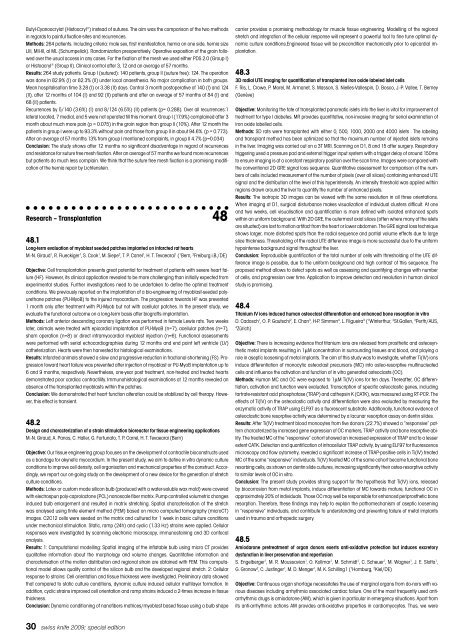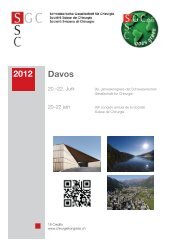Abstracts - Chirurgie Kongress
Abstracts - Chirurgie Kongress
Abstracts - Chirurgie Kongress
Create successful ePaper yourself
Turn your PDF publications into a flip-book with our unique Google optimized e-Paper software.
Butyl-Cyanoacrylat (Histoacryl ® ) instead of sutures. The aim was the comparison of the two methods<br />
in regards to painful fixation-sites and recurrences.<br />
Methods: 264 patients. Including criteria: male sex, first manifestation, hernia on one side, hernia size<br />
LIII, MII-III, al ML (Schumpelick). Randomization preoperatively. Operative exposition of the groin followed<br />
over the usual access in any cases. For the fixation of the mesh we used either PDS 2.0 (Group I)<br />
or Histoacryl ® (Group II). Clinical control after 3, 12 and an average of 57 months.<br />
Results: 264 study patients. Group I (sutured): 140 patients, group II (suture free): 124. The operation<br />
was done in 82.9% (I) or 82.3% (II) under local anaesthesia. No major complication in both groups.<br />
Mean hospitalisation time 3.28 (I) or 3.38 (II) days. Control 3 month postoperative of 140 (I) and 124<br />
(II), after 12 months of 104 (I) and 92 (II) patients and after an average of 57 months of 84 (I) and<br />
68 (II) patients.<br />
Recurrences by 5/140 (3.6%) (I) and 8/124 (6.5%) (II) patients (p= 0.288). Over all recurrences:1<br />
lateral located, 7 medial, and 5 were not operated till this moment. Group I (17.9%) complained after 3<br />
month about much more pain (p = 0.075) in the groin region than group II (10%). After 12 month the<br />
patients in group I were up to 93.3% without pain and those from group II in about 94.6%. (p = 0.773).<br />
After an average of 57 months 13% from group I mentioned complaints, in group II 4.7% (p=0.034)<br />
Conclusion: The study shows after 12 months no significant disadvantage in regard of recurrences<br />
and resistance for suture free mesh fixation. After an average of 57 months we found more recurrences<br />
but patients do much less complain. We think that the suture free mesh fixation is a promising modification<br />
of the hernia repair by Lichtenstein.<br />
Research – Transplantation 48<br />
48.1<br />
Long-term evaluation of myoblast seeded patches implanted on infarcted rat hearts<br />
M.-N. Giraud 1 , R. Flueckiger 1 , S. Cook 1 , M. Siepe 2 , T. P. Carrel 1 , H. T. Tevaearai 1 ( 1 Bern, 2 Freiburg i.B./DE)<br />
Objective: Cell transplantation presents great potential for treatment of patients with severe heart failure<br />
(HF). However, its clinical application revealed to be more challenging than initially expected from<br />
experimental studies. Further investigations need to be undertaken to define the optimal treatment<br />
conditions. We previously reported on the implantation of a bio-engineering of myoblast-seeded polyurethane<br />
patches (PU-MyoB) to the injured myocardium. The progression towards HF was prevented<br />
1 month only after treatment with PU-Myob but not with acellular patches. In the present study, we<br />
evaluate the functional outcome on a long-term basis after biografts implantation.<br />
Methods: Left anterior descending coronary ligation was performed in female Lewis rats. Two weeks<br />
later, animals were treated with epicardial implantation of PU-MyoB (n=7), acellular patches (n=7),<br />
sham operation (n=8) or direct intramyocardial myoblast injection (n=6). Functional assessments<br />
were performed with serial echocardiographies during 12 months and end point left ventricle (LV)<br />
catheterization. Hearts were then harvested for histological examinations.<br />
Results: Infarcted animals showed a slow and progressive reduction in fractional shortening (FS). Progression<br />
toward heart failure was prevented after injection of myoblast or PU-MyoB implantation up to<br />
6 and 9 months, respectively. Nevertheless, one-year post treatment, non-treated and treated hearts<br />
demonstrated poor cardiac contractility. Immunohistological examinations at 12 months revealed an<br />
absence of the transplanted myoblasts within the patches.<br />
Conclusion: We demonstrated that heart function alteration could be stabilized by cell therapy. However,<br />
this effect is transient.<br />
48.2<br />
Design and characterization of a strain stimulation bioreactor for tissue engineering applications<br />
M.-N. Giraud, A. Panos, C. Haller, G. Fortunato, T. P. Carrel, H. T. Tevaearai (Bern)<br />
Objective: Our tissue engineering group focuses on the development of contractile bioconstructs used<br />
as a bandage for akynetic myocardium. In the present study, we aim to define in vitro dynamic culture<br />
conditions to improve cell density, cell organisation and mechanical properties of the construct. Accordingly,<br />
we report our on-going study on the development of a new device for the generation of stretch<br />
culture conditions.<br />
Methods: Latex or custom made silicon bulb (produced with a water-soluble wax mold) were covered<br />
with electrospun poly-caprolactone (PCL) nanoscale fiber matrix. Pump controlled volumetric changes<br />
induced bulb enlargement and resulted in matrix stretching. Spatial characterisation of the stretch<br />
was analysed using finite element method (FEM) based on micro computed tomography (microCT)<br />
images. C2C12 cells were seeded on the matrix and cultured for 1 week in basic culture conditions<br />
under mechanical stimulation. Static, ramp (24h) and cyclic (1.33 Hz) strains were applied. Cellular<br />
responses were investigated by scanning electronic microscopy, immunostaining and 3D confocal<br />
analysis.<br />
Results: 1: Computational modelling: Spatial imaging of the inflatable bulb using micro CT provides<br />
qualitative information about the morphology and volume changes. Quantitative information and<br />
characterisation of the motion distribution and regional strain are obtained with FEM. This computational<br />
model allows quality control of the silicon bulb and the developed regional stretch. 2: Cellular<br />
response to strains: Cell orientation and tissue thickness were investigated. Preliminary data showed<br />
that compared to static culture conditions, dynamic culture induced cellular multilayer formation. In<br />
addition, cyclic strains improved cell orientation and ramp strains induced a 2-times increase in tissue<br />
thickness.<br />
Conclusion: Dynamic conditioning of nanofibers matrices/myoblast based tissue using a bulb shape<br />
30 swiss knife 2009; special edition<br />
carrier provides a promising methodology for muscle tissue engineering. Modelling of the regional<br />
stretch and integration of the cellular response will represent a powerful tool to fine tune optimal dynamic<br />
culture conditions.Engineered tissue will be precondition mechanically prior to epicardial implantation.<br />
48.3<br />
3D radial UTE imaging for quantification of transplanted iron oxide labeled islet cells<br />
F. Ris, L. Crowe, P. Morel, M. Armanet, S. Masson, S. Nielles-Vallespin, D. Bosco, J.-P. Vallee, T. Berney<br />
(Genève)<br />
Objective: Monitoring the fate of transplanted pancreatic islets into the liver is vital for improvement of<br />
treatment for type I diabetes. MR provides quantitative, non-invasive imaging for serial examination of<br />
iron oxide labelled cells.<br />
Methods: SD rats were transplanted with either 0, 500, 1000, 2000 and 4000 islets . The labeling<br />
and transplant method has been optimized so that the maximum number of injected islets remains<br />
in the liver. Imaging was carried out on a 3T MRI. Scanning on D1, 8 and 15 after surgery. Respiratory<br />
triggering used a pressure pad and external trigger input system with a trigger delay of around 150ms<br />
to ensure imaging is at a constant respiratory position over the scan time. Images were compared with<br />
the conventional 2D GRE signal loss sequence. Quantitative assessment for comparison of the numbers<br />
of cells included measurement of the number of pixels (over all slices) containing enhanced UTE<br />
signal and the distribution of the level of this hyperintensity. An intensity threshold was applied within<br />
regions drawn around the liver to quantify the number of enhanced pixels.<br />
Results: The isotropic 3D images can be viewed with the same resolution in all three orientations.<br />
When imaging at D1, surgical disturbance makes visualization of individual clusters difficult. At one<br />
and two weeks, cell visualisation and quantification is more defined with isolated enhanced spots<br />
within an uniform background. With 2D GRE, the outermost axial slices (often where many of the islets<br />
are situated) are lost to motion artifact from the heart or lower abdomen. The GRE signal loss technique<br />
shows larger, more distorted spots than the radial sequence and partial volume effects due to large<br />
slice thickness. Thresholding of the radial UTE difference image is more successful due to the uniform<br />
hypointense background signal throughout the liver.<br />
Conclusion: Reproducible quantification of the total number of cells with thresholding of the UTE difference<br />
image is possible, due to the uniform background and high contrast of this sequence. The<br />
proposed method allows to detect spots as well as assessing and quantifying changes with number<br />
of cells, and progression over time. Application to improve detection and resolution in human clinical<br />
study is promising.<br />
48.4<br />
Titanium IV ions induced human osteoclast differentiation and enhanced bone resorption in vitro<br />
D. Cadosch 1 , O. P. Gautschi 2 , E. Chan 3 , H-P. Simmen 4 , L. Filgueira 3 ( 1 Winterthur, 2 St.Gallen, 3 Perth/AUS,<br />
4 Zürich)<br />
Objective: There is increasing evidence that titanium ions are released from prosthetic and osteosynthetic<br />
metal implants resulting in 1µM concentration in surrounding tissues and blood, and playing a<br />
role in aseptic loosening of metal implants. The aim of this study was to investigate, whether Ti(IV) ions<br />
induce differentiation of monocytic osteoclast precursors (MC) into osteo-resorptive multinucleated<br />
cells and influence the activation and function of in vitro generated osteoclasts (OC).<br />
Methods: Human MC and OC were exposed to 1µM Ti(IV) ions for ten days. Thereafter, OC differentiation,<br />
activation and function were evaluated. Transcription of specific osteoclastic genes, including<br />
tartrate-resistant acid phosphatase (TRAP) and cathepsin K (CATK), was measured using RT-PCR. The<br />
effects of Ti(IV) on the osteoclastic activity and differentiation were also evaluated by measuring the<br />
enzymatic activity of TRAP using ELF97 as a fluorescent substrate. Additionally, functional evidence of<br />
osteoclastic bone resorptive activity was determined by a lacunar resorption assay on dentin slides.<br />
Results: After Ti(IV) treatment blood monocytes from five donors (22.7%) showed a “responsive” pattern<br />
characterized by increased gene expression of OC markers, TRAP activity and bone resorptive ability.<br />
The treated MC of the “responsive” cohort showed an increased expression of TRAP and to a lesser<br />
extent CATK. Detection and quantification of intracellular TRAP activity, by using ELF97 for fluorescence<br />
microscopy and flow cytometry, revealed a significant increase of TRAP-positive cells in Ti(IV) treated<br />
MC of the same “responsive” individuals. Ti(IV) treated MC of the same cohort became functional bone<br />
resorbing cells, as shown on dentin slide cultures, increasing significantly their osteo-resorptive activity<br />
to similar levels of OC in vitro.<br />
Conclusion: The present study provides strong support for the hypothesis that Ti(IV) ions, released<br />
by biocorrosion from metal implants, induce differentiation of MC towards mature, functional OC in<br />
approximately 20% of individuals. Those OC may well be responsible for enhanced periprosthetic bone<br />
resorption. Therefore, these findings may help to explain the pathomechanism of aseptic loosening<br />
in “responsive” individuals, and contribute to understanding and preventing failure of metal implants<br />
used in trauma and orthopedic surgery.<br />
48.5<br />
Amiodarone pretreatment of organ donors exerts anti-oxidative protection but induces excretory<br />
dysfunction in liver preservation and reperfusion<br />
S. Engelberger 1 , M. R. Moussavian 1 , O. Kollmar 1 , M. Schmidt 1 , C. Scheuer 1 , M. Wagner 1 , J. E. Slotta 1 ,<br />
G. Gronow 2 , C. Justinger 1 , M. D. Menger 1 , M. K. Schilling1 ( 1 Homburg, 2 Kiel/DE)<br />
Objective: Continuous organ shortage necessitates the use of marginal organs from do-nors with various<br />
diseases including arrhythmia associated cardiac failure. One of the most frequently used antiarrhythmic<br />
drugs is amiodarone (AM), which is given in particular in emergency situations. Apart from<br />
its anti-arrhythmic actions AM provides anti-oxidative properties in cardiomyocytes. Thus, we were



